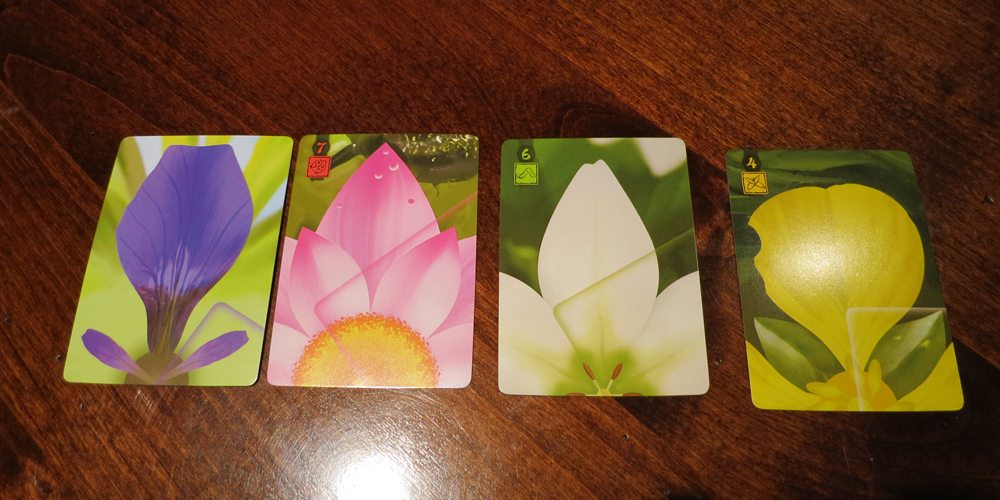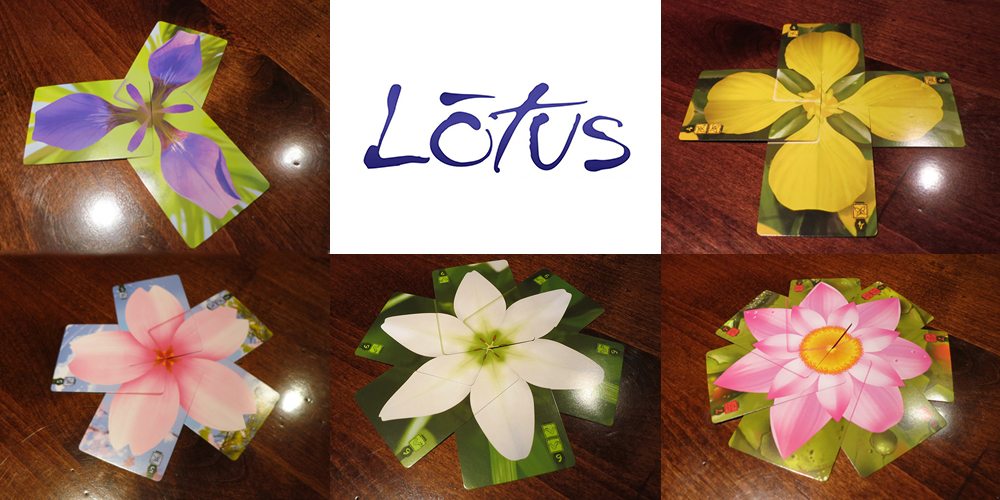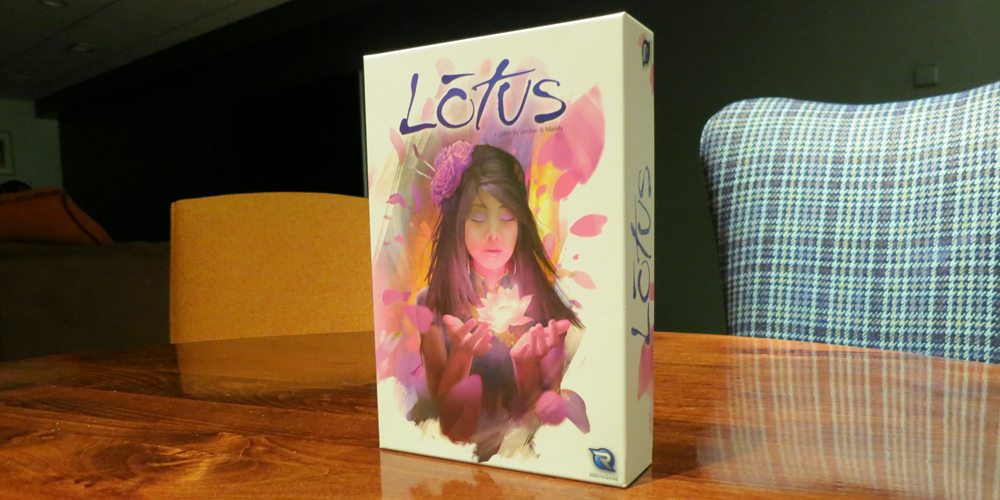
At a glance
The mystical Lotus Garden, hidden for centuries but recently discovered, provides eternal life and lasting wisdom to those who possess them. Nurture the garden to mature and lasting beauty so that you might harness these powers in this hand management/area control game for two to four players, aged eight and up, that plays in about 30 minutes. Will enlightenment be yours?
Components
In the box for the game Lotus, you’ll find 144 really beautiful cards of great quality. The cards are broken into 5 decks — one for each player and a wild deck, with each deck consisting of petals from five different flowers: irises, primroses, cherry blossoms, lilies, and lotuses.

Additionally, there is a handful of cardboard in the form of scoring tokens and special power tokens that give extra advantages to players. The artwork on these tokens is sort of nebulous and it’s not easy to figure out which one is which, but the title of the token and its capability is printed on its obverse.
Additionally, there are a dozen wooden pieces. Each of these pieces is representative of a “guardian” or an insect that helps players control the garden. There’s a butterfly, a ladybug, a dragonfly, and a caterpillar. Each gets two tokens, plus a silver “Elder Guardian” piece for that character. They all look like they should, except the caterpillar, which looks like … I don’t know what. There’s not a lot in terms of components, but what’s here is good quality and beautiful.
How to Play
Setup is pretty simple. Each player chooses a guardian, grabs the two associated guardian pieces and deck. Everyone shuffles their decks (you may need to remove some cards, depending on the number of players) and deals themselves a starting hand of four cards. The wildflower (wild) deck is shuffled and four cards are dealt from it, from which players can draw. The Elder Guardian pieces are set to the side, along with the scoring tokens and enough of each of the three power token types equal to the number of players. Now you’re ready to go.

During play, each player has the opportunity to perform two actions. These can be performed in any order and may be repeated. The actions are as follows: a player may play one or two cards on a single flower in the Lotus Garden. Note the ability to play more than one card. A player may also exchange one or two cards from her hand to her deck, taking from the top and returning to the bottom. Finally, a player can move a Guardian token, either to a flower from his supply or a move between flowers.
When playing cards, petals must be played on the same cards. That is, you can’t play an iris card on a primrose and so on. The cards have these great frames or outlines of where successive cards should be played, which helps players remember how many petals can be played on a flower. Irises only have three petals (or cards), primroses, four; cherry blossoms, five; lilies, six; and lotuses, seven. Only one flower of any particular type can exist in the garden at a time.

If, during a player’s turn, a flower is completed, a couple of things happen. The first is that control of the flower is determined. This is done by adding up the various Guardian icons on the cards (if, for example, you’re playing the ladybug character, all of your cards have one or two ladybug icons on them). Any Guardian tokens are then added in, each being worth another point. (The Elder Guardians, if in play, are worth two.) Whoever has control, and there can be ties, has the choice of taking a token worth five victory points at the end of the game or taking one of the three power tokens, which she can use until the end of the game.
The three power tokens include the Elder Guardian, which awards a single, silver Guardian token that a player can use and is counted twice when determining control. The Enlightened Path token allows players to have five cards in their hand, beginning with the next draw phase. Infinite Growth allows a player to play three (or more) cards on a single flower during his turn.

The second thing that happens upon completion of a flower is that the player who played the card that completed the flower gets to keep all the cards making up that flower. Each card is worth a victory point at the end of the game. Guardians are returned to their respective players.
At the conclusion of each turn, players draw back up to their hand limit and can take cards showing from the wildflower deck. These cards can help complete flowers, but don’t have Guardian icons on them, so don’t help with establishing control. Play continues until a player exhausts her draw deck. After that, everyone (including that player who drew the final card) gets a final turn. Cards and scoring tokens are totaled and the player with the most points wins!
Verdict
Lotus is a game that is beautiful, serene, and even a bit meditative. As the garden grows and flowers near completion, you’ll find a kind of peacefulness at your game table, which you may have never experienced before. During the first few times we played Lotus, I found myself wishing that there were fewer power tokens. I was trying to imagine ways that the game could be more competitive. But then I closed my eyes, inhaled deeply, and realized that Lotus is nearly perfect as it is.

Even when everyone has the same advantages, there is enough luck in the drawing of cards, enough strategy in how the petals are played and Guardians placed that it is an enjoyable and challenging game. Yes, it is on the lighter side and I can’t tell if it’s a game that will keep hitting the table, but it’s easy to teach, quick to get playing, and everyone I’ve shown it to really likes it — probably because Lotus is a very calm and lovely experience.
Renegade Game Studios has been on a roll lately and I’m a big fan of their lineup. With games like Lanterns, Fuse, World’s Fair 1893, Apotheca, and John Kovalic’s ROFL!, they have some outstanding games. Plus there’s Clank! (look for a review from Jonathan Liu soon) and Covert, which I just bought at my game store, and these are just some of the games that Renegade publishes. It’s a pretty impressive lineup of well-received games and Lotus certainly belongs in that company.
I think, after playing Lotus for a while, the only wish I had from my first play that still nagged at me after my last one was the desire for all the flowers to stay on the table. What a magnificent tableau that would make. They do have to come off so that the points can be counted, but the bouquet you could grow, if they stayed, would be gorgeous. Still, it’s a game that the whole family can enjoy and is easily accessible for gamers and non-gamers alike.
Lotus is available now and retails for just $30.00.

Disclosure: GeekDad was sent a sample of this game for review purposes.


